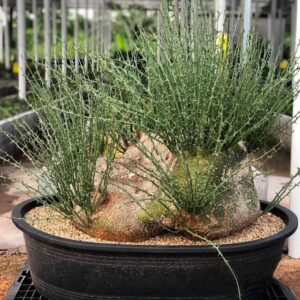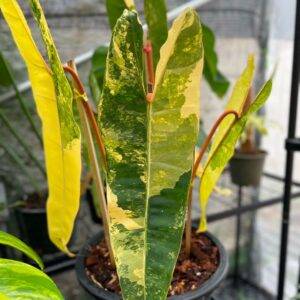Pachypodium saundersii: The Unique Kudu Lily
Pachypodium saundersii, commonly known as the Kudu Lily or Bottle Tree, is a fascinating caudex shrub native to South Africa. Belonging to the Apocynaceae family, this plant is celebrated for its unique appearance, adaptability to arid environments, and striking seasonal blooms. Below, we explore its characteristics, care requirements, and why it makes an excellent addition to any succulent enthusiast’s collection.
Characteristics of Pachypodium saundersii
-
Appearance: This shrub typically grows to a height of 2-5 feet. It is distinguished by its swollen, bottle-like trunk that stores water—a vital adaptation for survival in dry environments. Its thorny branches and neat grey-green foliage add to its striking visual appeal.
-
Flowers: During the summer months, Pachypodium saundersii produces stunning pink or white flowers that contrast beautifully with its foliage. These blooms make it a standout feature in any garden.
-
Dormancy: The plant is deciduous and enters a dormancy period during cooler months, shedding its leaves to conserve energy.
Natural Habitat
Pachypodium saundersii thrives in xeric (dry) environments such as rocky outcrops and steep hills in South Africa. These micro-environments often differ significantly from the surrounding biomes, providing the plant with specialized conditions like fluctuating moisture levels and high exposure to sunlight. Its ability to grow in shallow soil and withstand extreme drought makes it a resilient species.
Care Requirements
Proper care ensures Pachypodium saundersii remains healthy and vibrant. Here are key considerations:
Light
-
The Kudu Lily thrives in bright, direct sunlight for at least 8 hours daily. If grown indoors, placing it near a south-facing window will ensure adequate light exposure.
Watering
-
Water sparingly during its growing season, allowing the soil to dry completely between waterings. Reduce watering significantly during dormancy to prevent root rot.
Soil
-
Use sandy soil with excellent drainage. A cactus or succulent mix is ideal for this plant.
Temperature
-
Pachypodium saundersii prefers warm temperatures and cannot tolerate frost. If winter temperatures drop too low, move the plant indoors or cover it for protection.
Fertilizer
-
Apply a balanced fertilizer (5-10-10) once a month during the growing season. Avoid over-fertilization as it can harm the plant.
Repotting
-
Repot every 2-3 years or when the plant outgrows its container. Ensure the new pot has good drainage to prevent waterlogging.
Propagation
-
Propagate via seeds or cuttings. Seeds should be sown in well-draining soil and kept warm until germination. Cuttings should be allowed to callous before planting.
Pruning and Maintenance
Prune dead or damaged branches during the growing season using clean, sharp tools. Regularly inspect for pests like mealybugs and spider mites, which can damage the plant if left unchecked.
Safety Considerations
The sap of Pachypodium saundersii is toxic if ingested and can cause skin irritation. Handle with care and keep it out of reach of children and pets.
Why Choose Pachypodium saundersii?
This unique shrub offers several benefits:
-
Aesthetic Appeal: Its sculptural trunk, thorny branches, and vibrant flowers make it a centerpiece in any garden.
-
Low Maintenance: With minimal watering needs and adaptability to dry conditions, it’s perfect for busy gardeners.
-
Resilience: Its ability to thrive in harsh environments makes it an excellent choice for xeriscaping.
Conclusion
Pachypodium saundersii is more than just a plant; it’s a statement piece that combines beauty with resilience. Whether you’re an experienced succulent collector or a beginner looking for a hardy addition to your garden, this South African native is sure to impress with its dramatic appearance and easy-care nature.
By incorporating proper care techniques—such as providing ample sunlight, using well-draining soil, and protecting it from frost—you can enjoy the unique charm of this remarkable shrub year-round.
What are the unique characteristics of Pachypodium saundersii
Pachypodium saundersii, commonly known as the Kudu Lily, is a unique succulent shrub with several distinct characteristics that make it stand out among other plants. Below are its most notable features:
1.
This plant is characterized by its prominent tuberous stem, which can grow up to 1 meter in diameter and is often irregularly shaped. The stem serves as a water storage organ, enabling the plant to survive long periods of drought in its native dry habitats.
2.
The branches of Pachypodium saundersii are covered with paired spines that range from 20 to 70 mm in length. These spines not only protect the plant from herbivores but also help collect dew, which drips down to the roots, providing additional moisture.
3.
This shrub is deciduous, shedding its leaves during cooler months to conserve energy. Its ability to enter dormancy during unfavorable conditions makes it well-adapted to fluctuating climates.
4.
The leaves are medium-green on top and paler underneath, with a glossy texture. They are thinly textured and range from 30-80 mm in length and 10-40 mm in width, adding an elegant touch to the plant’s appearance.
5.
Pachypodium saundersii produces large showy flowers at the tips of its stems, mainly in autumn and early winter (February-May). The flowers are white with pink or purple flushes on the outside and greenish hues inside the corolla tube, making them visually striking.
6.
The fruit consists of two horn-like mericarps that split open to release numerous small seeds equipped with tufts of whitish hairs for wind dispersal. This adaptation ensures the plant’s seeds can travel far from the parent plant.
7.
Its thick stem and pale bark reflect sunlight, helping it stay cool in hot conditions. The ability to store water in its trunk allows Pachypodium saundersii to thrive in rocky crevices and dry woodland areas of Southern Africa.
8.
Pachypodium saundersii exhibits pachycaul growth—a thickened trunk adapted for water storage—and spinescence (presence of spines). These features vary depending on environmental conditions, showcasing the plant’s adaptability to microhabitats.
These unique characteristics make Pachypodium saundersii not only a resilient survivor in harsh environments but also a visually captivating addition to gardens or collections of succulents




Reviews
There are no reviews yet.